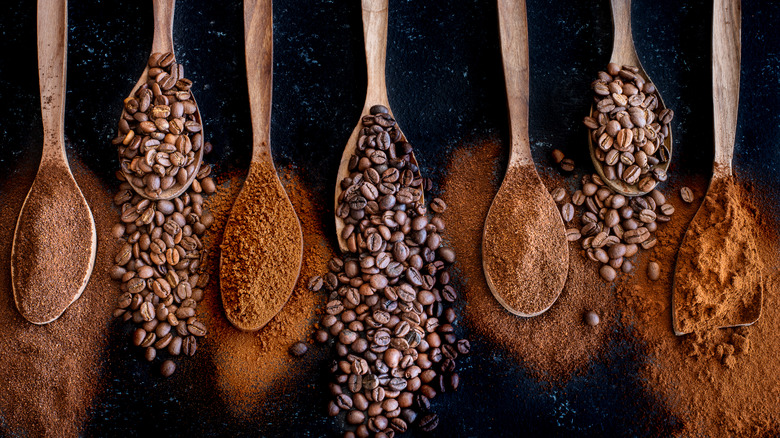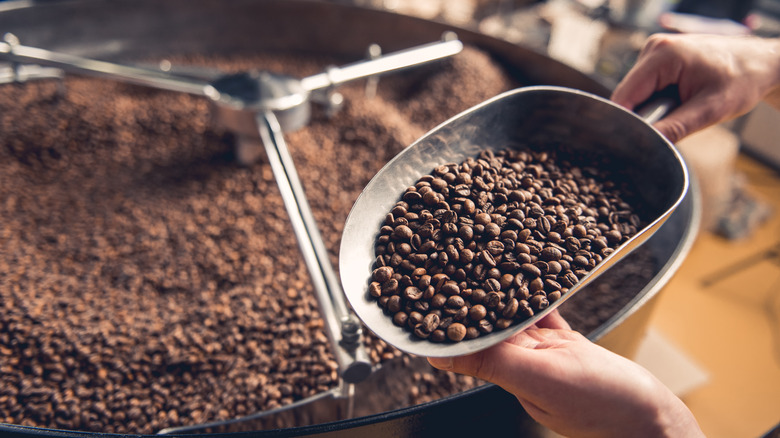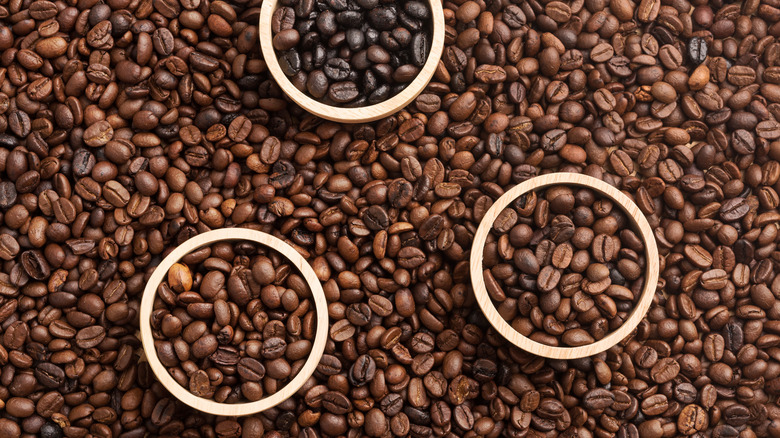What Exactly Is A Coffee Blend?
Coffee beans are a highly nuanced medium, and judging by the data, fans are digging it all. According to Coffee Affection, U.S. coffee fans drink coffee more frequently than tap water. Across the country, it's estimated that 517 million cups of coffee are sipped on per day — so, what type of coffee is typically consumed?
A trip to the grocery store will present consumers with literal walls of options. Folgers, Green Mountain, Café Bustelo, Eight O'Clock, and Maxwell House are all solid, and they're only supermarket staples. What about the specialty small-batch coffees sold in bags for $19 a pop? It can be a little overwhelming to know which types will suit your taste.
Plus, if you ask human behavioral expert Darren Stanton, your coffee choice might indicate something deeper about your personality. Stanton shares that espresso fans are "adventurous" and "powerful," and flat white drinkers tend to be "quite single-minded, fairly outspoken" (via DailyMail).
Whether or not your coffee choice goes that deep, we're talking about one specific type of coffee on the market — or, perhaps, it's not so specific. You've seen them; maybe there's even a bag in your pantry at this moment: coffee blends. Per Coffee Bean Corral, cafés, roasters, and large-scale distributors all make their own blends. If you've spied the words "Breakfast Blend" or "Espresso Blend," then you know what we're talking about here. Or, maybe you don't. What exactly is a coffee blend?
Coffee blends depend on complementary flavor profiles
A coffee blend is any made from the combination of two or more different coffees, states Japanese Coffee Co. For instance, if you grind a Brazilian coffee and a Colombian coffee together, that's a blend. In fact, many light roast coffees are a blend of Colombian, Brazilian, and Ethiopian beans. Or, as Coffee Hero points out, blends can also refer to beans from different regions within the same country, like an Ethiopia Yirgacheffe, Ethiopia Guji, and Ethiopia Sidamo Ardi mix.
Taylor Lane Organic Coffee notes, "Coffee blends are the opposite of single-origin coffee." For instance, the common "mocha java" blend is typically equal parts of beans from Mocha, Java, Yemen, Indonesia, or Ethiopia. But different blends don't always work well together. Coffee Bros Roastery claims the key to creating a successful coffee blend is understanding the unique profile of your beans and playing matchmaker-flavor accordingly.
A fruity, acidic Ethiopia might clash with a floral Peru. But, an Ethiopia-Brazil blend would fuse citrus with chocolate for added flavor complexity, per Coffee Hero. Or Guatemalan and Zambian coffees yield a "tart apple and almond blend" when combined.
Creativity is encouraged here — just make sure not to overdo it. According to Jen Apodaca, director of roasting for The Crown: Royal Coffee Lab and Tasting Room in California, blending any more than five different beans is probably a bad idea (via Perfect Daily Grind). So, why do roasters choose to make blends? And why do consumers opt to drink blends?
Coffee blends are complex and consistent
Coffee blends have garnered a sort of unsavory reputation as being of lesser quality, but they present some major benefits for both producers and consumers alike. As Jen Apodaca explains, "[T]he reason why most roasters create blends is because consumers demand a flavor profile that is repeatable and consistent...year-round."
With blends, roasters don't have to rely on in-season beans. Plus, blends also cost less than relying on a single origin bean or even a single batch from a micro-lot, as in many specialty coffees, per Taylor Lane Organic Coffee.
From an artistic standpoint, creating a "signature blend" establishes a roaster's position as a brand — meaning consumers can know what to expect when they buy a specific product. Apodaca states that with any coffee blend, the ultimate goal is always to create a better product than what already exists. Pairing two or more single-origin beans should add up to a blend that's greater than the sum of its parts. Blending creates a totally unique flavor profile that the individual beans couldn't achieve on their own.


